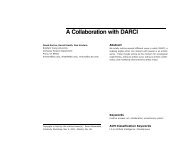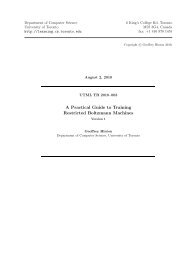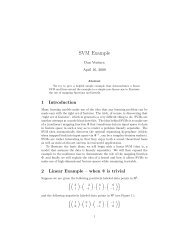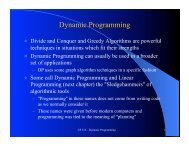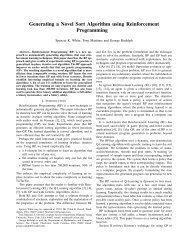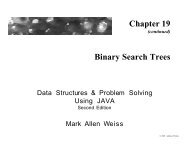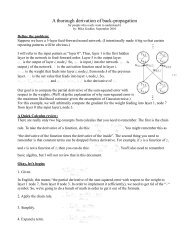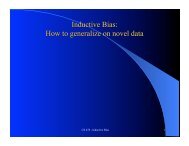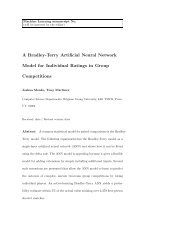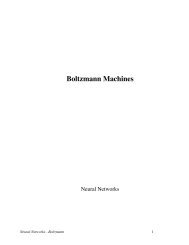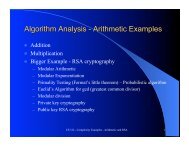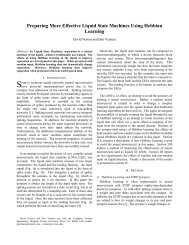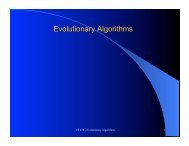Toward Optimal Active Learning through Sampling ... - CiteSeerX
Toward Optimal Active Learning through Sampling ... - CiteSeerX
Toward Optimal Active Learning through Sampling ... - CiteSeerX
You also want an ePaper? Increase the reach of your titles
YUMPU automatically turns print PDFs into web optimized ePapers that Google loves.
Accuracy<br />
0.86<br />
0.84<br />
0.82<br />
0.8<br />
0.78<br />
0.76<br />
0.74<br />
Accuracy on Job Categorization<br />
0.72<br />
Error-Reduction <strong>Sampling</strong><br />
Density-weighted QBC<br />
0.7<br />
0 5 10 15 20 25 30 35 40<br />
Number of Added Labeled Examples<br />
Figure 4. A magnified view of the average test set accuracy for<br />
the Job Category domain, distinguishing one job category from 5<br />
others. The Error-Reduction <strong>Sampling</strong> algorithm clearly reaches<br />
a high level of accuracy much before the Density-Weighted QBC<br />
algorithm.<br />
models that are complex and have complex parameter<br />
spaces, not all regions of which are relevant to performance<br />
on a particular data set. In these situations active learning<br />
methods based on version space reduction would not be<br />
expected to work as well, since they will expend effort excluding<br />
portions of version space that have no impact on<br />
expected error.<br />
We plan to extend this active learning technique to other<br />
classifiers, such as Support Vector Machines. The recent<br />
work by Cauwenberghs and Poggio (2000) describes techniques<br />
for efficient incremental updates to SVMs and will<br />
apply to our approach.<br />
Acknowledgements<br />
Both authors were supported by Whizbang! Labs for this<br />
work. The authors would like to thank Andrew Ng for his<br />
advice and suggestions. Fernando Pereira, Kamal Nigam,<br />
Simon Tong and Pedro Domingos provided much valuable<br />
feedback and suggestions of earlier versions of this paper,<br />
as did the anonymous reviewers.<br />
References<br />
Abe, N., & Mamitsuka, H. (1998). Query learning strategies using<br />
boosting and bagging. International Conference on Machine<br />
<strong>Learning</strong> (ICML).<br />
Argamon-Engelson, S., & Dagan, I. (1999). Committee-based<br />
sample selection for probabilistic classifiers. Journal of Artificial<br />
Intelligence Research, 11, 335–460.<br />
Breiman, L. (1996). Bagging predictors. Machine <strong>Learning</strong>, 24,<br />
123–140.<br />
Cauwenberghs, G., & Poggio, T. (2000). Incremental and decremental<br />
support vector machine learning. Advances in Neural<br />
Information Processing 13 (NIPS). Denver, CO.<br />
Cohn, D. A., Ghahramani, Z., & Jordan, M. I. (1996). <strong>Active</strong><br />
learning with statistical models. Journal of Artificial Intelligence<br />
Research, 4, 129–145.<br />
Domingos, P. (2000). Bayesian averaging of classifiers and the<br />
overfitting problem. Proceedings of the International Conference<br />
on Machine <strong>Learning</strong> (ICML) (pp. 223–230).<br />
Freund, Y., Seung, H., Shamir, E., & Tishby, N. (1997). Selective<br />
sampling using the Query By Committee algorithm. Machine<br />
<strong>Learning</strong>, 28, 133–168.<br />
Grove, A., & Schuurmans, D. (1998). Boosting in the limit: Maximizing<br />
the margin of learned ensembles. Proc. of the Fifteenth<br />
National Conference on Artificial Intelligence (AAAI-98).<br />
Joachims, T. (1998). Text categorization with support vector machines:<br />
<strong>Learning</strong> with many relevant features. Proceedings of<br />
the European Conference on Machine <strong>Learning</strong>.<br />
Lewis, D., & Gale, W. (1994). A sequential algorithm for training<br />
text classifiers. Proceedings of the International ACM-SIGIR<br />
Conference on Research and Development in Information Retrieval<br />
(pp. 3–12).<br />
Liere, R., & Tadepalli, P. (1997). <strong>Active</strong> learning with committees<br />
for text categorization. Proceedings of the National Conference<br />
in Artificial Intelligence (AAAI-97). Providence, RI.<br />
Lin, K. (1991). Divergence measures based on the Shannon entropy.<br />
IEEE Transactions on Information Theory, 97, 145–151.<br />
Lindenbaum, M., Markovitch, S., & Rusakov, D. (1999). Selective<br />
sampling for nearest neighbor classifiers. Proceedings<br />
of the Sixteenth National Conference on Artificial Intelligence<br />
(AAAI-99) (pp. 366–371).<br />
McCallum, A., & Nigam, K. (1998a). A comparison of event<br />
models for naive Bayes text classification. AAAI-98 Workshop<br />
on ”<strong>Learning</strong> for Text Categorization”.<br />
McCallum, A., & Nigam, K. (1998b). Employing EM and poolbased<br />
active learning for text classification. Proc. of the Fifteenth<br />
Inter. Conference on Machine <strong>Learning</strong> (pp. 359–367).<br />
Mitchell, T. M. (1982). Generalization as search. Artificial Intelligence,<br />
18.<br />
Nigam, K., Lafferty, J., & McCallum, A. (1999). Using maximum<br />
entropy for text classification. Proceedings of the IJCAI-99<br />
workshop on information filtering..<br />
Pereira, F., Tishby, N., & Lee, L. (1993). Distributional clustering<br />
of English words. Proceedings of the 31st ACL.<br />
Seung, H. S., Opper, M., & Sompolinsky, H. (1992). Query by<br />
committee. Proceedings of the Fifth Annual ACM Workshop<br />
on Computational <strong>Learning</strong> Theory (pp. 287–294).<br />
Tong, S., & Koller, D. (2000a). Support vector machine active<br />
learning with applications to text classification. Proc. of the<br />
Seventeenth International Conference on Machine <strong>Learning</strong>.<br />
Tong, S., & Koller, D. (2000b). <strong>Active</strong> learning for parameter estimation<br />
in Bayesian networks. Advances in Neural Information<br />
Processing 13 (NIPS).



